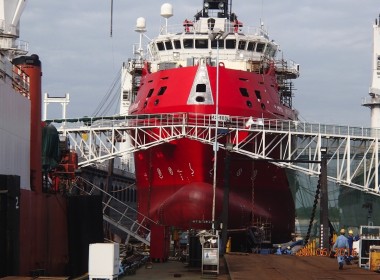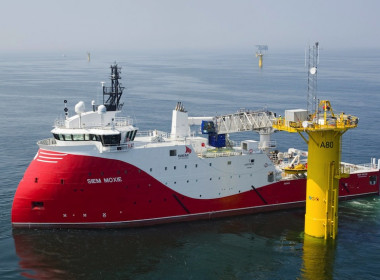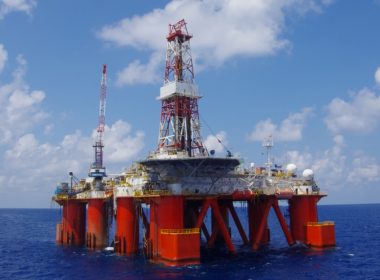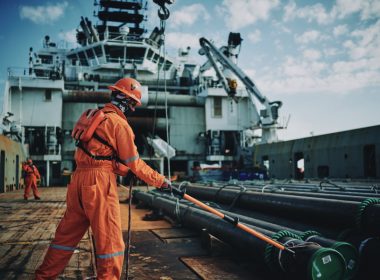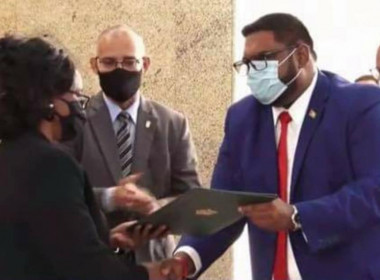COLUMN | The Twelve Days of Christmas 2023: Days 4 to 6: Seadrill, Gulf Drilling International and ADES; five shipping magnates on future fuels; six corrupted states and Al Jazeera [Offshore Accounts]

On the first day of Christmas my true love gave to me… a partridge in a pear tree, according to the ancient English carol, but at Baird Maritime, that’s the cue for a dozen topical features about the offshore industry.
Lovers of festive traditions get scrolling, as for the fourth year in a row, we are running through the Twelve Days of Christmas, from an energy perspective.
The first three days appeared last week (here) covering the latest on the Scottish ferry fiasco, two Windcat Offshore newbuilding orders, and three Azerbaijani journalists detained.
Now we move on through the traditional six geese a-laying, five gold rings and…
Four drilling assets-a-selling?
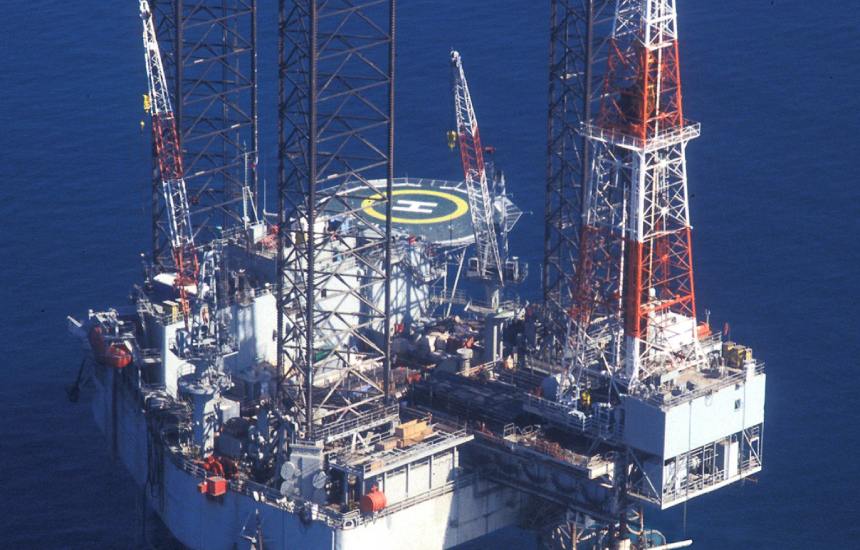
Between 2020 and 2022, state-owned drilling companies of Saudi Arabia and Abu Dhabi embarked on a frenzy of jackup rig acquisition. Between 2021 and 2023, Saudi Arabia’s state-owned ADES completed the acquisition of 26 jackup rigs, taking the company’s net debt to an eye-watering US$3.3 billion on September 30 of this year, a figure that dropped when the company received SAR3.1 billion (US$827 million) from its IPO a month later. You can view ADES’ November trading update and financials here.
There was a massive transfer of rigs from private international operators to the hands of the governments of the Middle East. In November 2021, ADES bought four jackups from Noble Corporation (paying US$285 million for Noble Roger Lewis, Noble Scott Marks, Noble Joe Knight, and Noble Johnny Whitstine), then in December of the same year, it agreed to buy three jackups from Vantage (Emerald Driller, Sapphire Driller, and Aquamarine Driller for US$170 million); in March 2022, ADES purchased Hakuryu 12 from Japan Drilling Company; in April 2022, it bought four Deep Driller rigs from India’s cash-strapped Aban Offshore for just over US$105 million, followed by Maersk Convincer for US$42.5 million from Maersk Drilling, two more jackups from Valaris in lay-up in the Philippines (being PPL Pacific Class 400 design Valaris 113 and Valaris 114), and one from Icon Offshore of Malaysia, which doubled its money in less than a year when it sold the Saudis the jackup Perisai Pacific 101 for US$85 million in September of last year.
ADES also bought two rigs (Argent 4 and Argent 5) from the creditors of the bankrupt Mexican contractor Oro Negro, and popped them on a heavy lift vessel to the Gulf from the Caribbean, and bareboated in four rigs, the abandoned Fecon-1 and Fecon-2 and Cantarell III and IV from Singapore’s feckless Keppel O&M (now Seatrium).
I am as breathless recounting that list as you are probably as perplexed reading it.
Seadrill sells seven
Then, to close the action with a bang, ADES bought seven jackup rigs (AOD I, AOD II, AOD III, West Callisto, West Ariel, West Cressida and West Leda) from Seadrill for a whopping US$628 million at the end of last year.
Since then, there has been silence from ADES, and no more purchases of jackups. Indeed, twelve of the rigs it bought had still not been re-activated and placed on contract to Saudi Aramco at the end of the last quarter.
Arabian Drilling and ARO join the fun
Saudi Arabia’s Arabian Drilling (an SLB affiliate) joined the fun by buying two Arabdrill 130 (the former Cantarell I) and Arabdrill 140 (ex-Cantarell II), and bareboating the abandoned newbuilds Fecon-3 and Clearwater JU Tbn4, (which became Arabdrill 110 and 120), also from Keppel O&M in 2022.
Then, ARO Drilling, a joint venture between Saudi Aramco and Valaris, recently took delivery of its first new build jackup, Kingdom-1, built in the UAE.
ADNOC Drilling – more production despite COP leadership
Never to be outdone by their Saudi neighbours, ADNOC Drilling purchased Oro Negro’s Pacific Class 400 jackups Argent 1, Argent 2, and Argent 3 in 2022, along with Aban’s Deep Driller 8, and joined ADES in both bareboating and acquiring additional units, in its case from China and Singapore.
At the end of 2020, ADNOC Drilling operated 20 jackups, but when it reported its results last month, its jackup fleet stood at 35 vessels, all working in Abu Dhabi, and all dedicated to increasing its parent company ADNOC’s oil production from three million barrels per day today to production capacity of five million barrels per day and one billion cubic feet (28.3 million cubic metres) of gas in 2027.
This is quite remarkable for a country that hosted the COP28 climate conference, and where the CEO of ADNOC, Sultan al-Jaber, was also the president of the carbon emission reduction body.
But I guess Abu Dhabi at least aspires to be green, unlike Azerbaijan, the host of the next COP summit.
“Please sir, I want some more”: Qatar as Oliver Twist
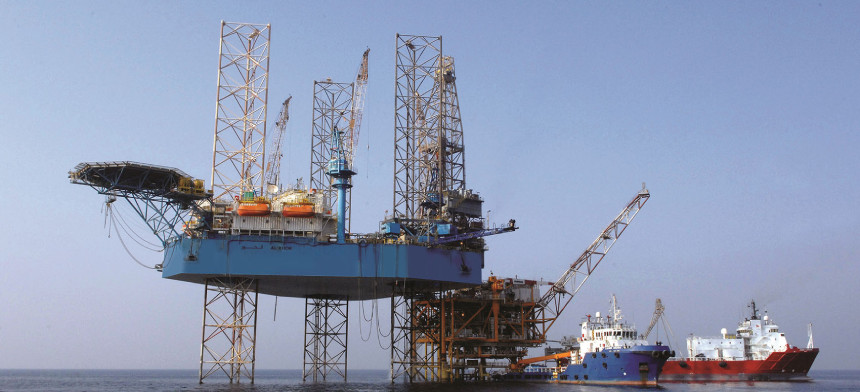
In total, 53 rigs moved into the Arabian Gulf in 2022 and 2023, including 35 to Saudi Aramco and 12 to ADNOC. Distinctly missing from this frenzy of acquisition was Qatar. Only four rigs moved to Qatar in this period and none of them were purchased by the country’s state drilling company Gulf Drilling International (GDI). GDI itself owns a fleet of just seven rigs and operated another five chartered in via its Gulfdrill joint venture with Seadrill. Gulfdrill bareboat charters three jackups from Seadrill, along with two other rigs.
Yes, I know, the country had the World Cup to pay for in 2022, and it apparently cost US$200 billion, so a certain reticence on its part is to be expected. However, it is unusual to see the world’s second largest liquefied natural gas (LNG) producer be dependent on third-party rigs, including three from ADES, when its Gulf neighbours are all splurging on buying their own.
This then brings us, in a most convoluted manner, to the four drilling assets a-selling in the verse of our carol. Whilst Tiny Tim from A Christmas Carol is more seasonal, Charles Dickens’ Oliver Twist and his appetite for “some more” is more apt for Qatar’s drilling fleet.
The four assets for sale are Seadrill’s three jackups West Castor, West Telesto, and West Tucana, all three of which are bareboat chartered by Seadrill to Gulfdrill, and, additionally, Seadrill’s 50 per cent equity interest in Gulfdrill itself. At the risk of making a fool of myself later, which doesn’t really concern me as I am both anonymous and humble, there can likely only be one buyer for these four Seadrill assets: Gulf Drilling International itself.
How much is in Christmas card?
So, the only question to vex Seadrill’s talented CEO Simon Johnson is “how much?” Given that the potential sale was announced in June, one assumes that some pretty hard negotiations are going on with Doha. Seadrill relisted on the US stock market in October last year after its bankruptcy filing at US$26.50 per share. On Friday, its stock closed at US$41.12, so shareholders are up 50 per cent in 14 months. Last month, the company’s board authorised an increase in Seadrill’s share buyback programme by another US$250 million to a total of US$500 million.
That cash has got to come from somewhere, and with Seadrill already warning of “heavy maintenance requirements” and “idle time” in 2024, the sale of the three jackups and the Gulfdrill shares to the Qatari partners for, say, US$350 million would be a nice one-time gain for the company. If that happened, Mr Johnson’s Christmases would have come all at once, the stock price would get a bump up, and GDI could finally boast that its owned rig count was in double digits.
Five Gold Rings green shipping leaders
Speaking of the COP 28 conference in Dubai, whom did we see prominently calling for the International Maritime Organisation (IMO) “to create the necessary regulatory conditions to expedite the transition from fossil fuels to green fuels,” and calling for an end date for the construction of fossil fuel-powered ships?
That would be the CEOs of Maersk, MSC, CMA CGM, Hapag-Lloyd, and Wallenius Wilhelmsen. You can read their festive proclamation here.
Maersk backs green methanol
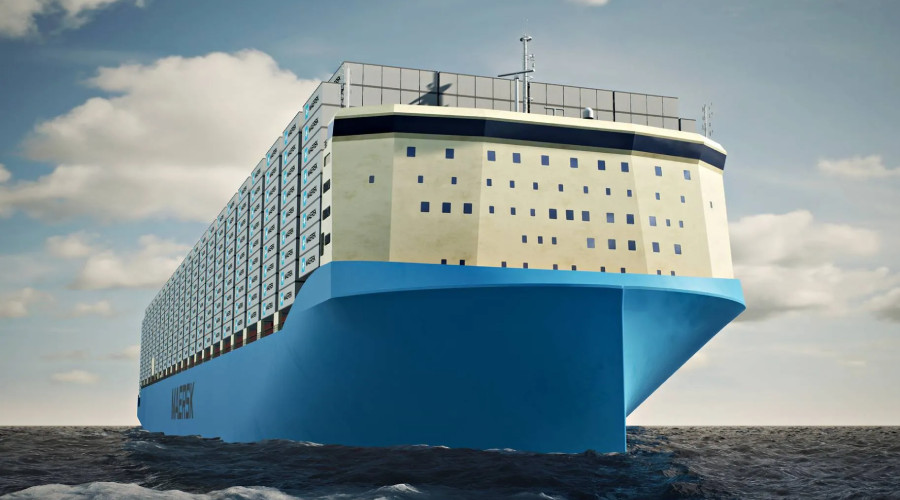
Of the five, Maersk is probably the one putting its money where its mouth is: Maersk has pledged to decarbonise its entire business by 2040, and has placed orders for 24 dual-fuel containerships capable of running on green methanol, 12 with capacity of 16,000 TEUs, six with 17,000 TEUs capacity each, and another six on order at the Yangzijiang Shipbuilding Group with a capacity of 9,000 TEUs apiece.
Since 2021, Maersk has had a policy of only ordering new vessels able to operate on green fuels. However, just because it can, it doesn’t necessarily mean that it will.
The first of the company’s green-fuel vessels, indeed the world’s first methanol-enabled container vessel, Laura Mærsk, a 2,100TEU feeder vessel, was named by the EU Commission President Ursula von der Leyen in Copenhagen in September. Maersk being Maersk, there are no details on the consumption of the methanol-powered vessels in either green mode or using conventional low-sulphur fuels, hence conveniently preventing us from being able to reverse-engineer a business case. Scrooges!
There are some clues…
X-press Feeders has 14 such dual-fuel methanol-powered containerships on order, and the company says that the ships will emit approximately 65 per cent fewer greenhouse gases from their main propulsion as compared to ships operating on conventional fuel (here).
Francis Goh, the company’s Chief Operating Officer, set out the economic challenge the new fuels face in a recent piece for the British Chamber of Commerce in Singapore.
Mr Goh explained that an X-Press Feeder vessel operating from Rotterdam to Portugal using green methanol reduces CO2e emissions by 268 kg per TEU, and the additional shipping cost equates to less than €0.025 for each pair of shoes (Let’s call it parity at US$0.025 for the sake of calculation.). He said that this was “a small price to pay for something that will make a big difference in reducing emissions.”
The COO pointed out one TEU container is large enough, for example, to transport 4,000 pairs of running shoes, so the extra cost per container is only US$1 and the total increased voyage cost for 1,086 nautical miles would be US$1,170 for the 1,170TEU methanol-fuelled vessels that X-press has on order.
A dollar a nautical mile to run a feeder vessel on a fuel that reduces emissions by 65 per cent. What a bargain!
Drewry provides a cold splash of reality
Unfortunately, Drewry comes up with drastically more expensive numbers for green methanol as a fuel. According to the shipping consultancy in its September Decarbonisation Update, the switch to green e-methanol will likely raise bunker costs by 340 per cent.
I will repeat that. By 340 per cent.
A ship that today spends US$20,000 on bunkers per day will in future spend US$68,000 per day. Given that Shanghai at Rotterdam takes a boxship over thirty days, and that medium-sized container vessels routinely burn over one hundred tonnes of fuel per day, the cost will not be insubstantial.
This is a bit of a difference from US$1 per container (or nautical mile). Drewry said that the calculation takes into account a higher price for green e-methanol and a full price for grey methanol plus green certificates, as well as a lower Emission Trading Scheme allowance cost of €100 (US$107.67) per tonne of CO2.
You don’t need to be Nostradamus to see that a 340 per cent increase in bunker fuel costs is going to be pretty damaging to the economics of those shipowners operating green fuel vessels compared to those operating regular heavy fuel oil-powered vessels.
So how do the shipping leaders square the circle?
At the heart of the scheme from the five green leaders is a call for “an effective Green House Gas pricing mechanism to make green fuel competitive with black fuel during the transition phase when both are used.” The five say this can be done by distributing the premium for the green fuels across all the fossil fuel used.
“With low initial volumes of green fuels, any inflationary effects are minimised,” they remarked. “The mechanism must also feature an increasing regulatory incentive to achieve deeper emissions reductions.”
What they are calling for is a tax on bunker fuels, so that methanol, hydrogen, and ammonia can be competitive with marine diesel and heavy fuel oil, and that all users of fossil fuels pay more to balance out the higher cost of green fuels.
This is going to mean higher shipping costs all around for containers. What’s interesting is that the container industry is so consolidated that probably the big liner companies can successfully lobby to achieve a carbon tax on bunkers, certainly in Europe, where subsidies (described as “public co-funding”) to Maersk are something we have covered before.
The four container trade signatories of the declaration already have over 50 per cent of global market share in the container trades. The top eight container carriers have over 80 per cent market share.
It’s for your own good
The world was used to the container lines co-ordinating pricing to maintain service and capacity (or whatever it was) through their “conferences” and claiming the ensuing price and capacity agreements they made together were good for customers.
Now, the bosses of the container lines have decided to invest heavily in green fuel, and we hear cries that prices need to go up to save the planet at the climate conferences. If Drewry is correct, consumers everywhere are going to have to get used to paying more for goods shipped by sea (And don’t get me started on the environmental footprint and cost of supposed “sustainable” aviation fuel…).
Those five green shipping leaders have their eyes focused on the green dollar bills to get a return on what will be billions of dollars of investment in green-fuelled ships. Today, and likely for the next decade, green fuels cannot compete with fossil fuels on price, so either high carbon taxes are going to be needed to make all that ammonia and green methanol economically viable in the short and probably the medium term, or the fuels will need large state subsidies.
It’s Christmas time, so perhaps I should be more charitable. But when you see shipping CEOs calling for higher taxes on bunkers across the board, we should believe them… and expect to be paying higher prices accordingly.
Six Bribes-a-paying
One of the most depressing films of all of 2023 was Al Jazeera’s The Gold Mafia, which sets out the chronic corruption and money laundering that go on in six countries: Ghana, South Africa, Zimbabwe, Venezuela, the UAE and Hong Kong.
You should watch all the four episodes. Al Jazeera’s investigative team goes undercover to show how money laundering works, and who is responsible in Southern Africa.
The documentary shows how the first class cabin of an Emirates flight between Dubai and Harare was full of portly gentlemen using their 50-kilogram baggage allowance and ample hand carry to smuggle hundreds of kilos of gold and then millions of dollars in cash. On film, the investigative reporters disguised as Hong Kong crime bosses capture all the links in the chain of dirty money, from security managers at Harare airport being paid to turn a blind eye to bullion passing through their scanners (the wonderfully named Cleopas Chidodo is very clear on this process), to gospel preachers with diplomatic passports, praise the Lord megachurches, and the ability to prophesy football results, requesting US$200,000 facilitation fees to arrange a meeting with the president of Zimbabwe, Emmerson Mnangagwa.
There are Dubai entrepreneurs (one of whom is also the founder of a charismatic church and a do-good charity) offering the services of their legitimate UAE free zone businesses to facilitate money laundering, along with claims that the UAE customs accepts bribes to ignore suitcases full of cash at Dubai airport. Surely not?
We hear from the brother and the wife of one of South Africa’s largest money launderers, a man known as “Mo Dollars,” about his use of shell companies in Hong Kong to facilitate advanced invoicing fraud and to fund his lavish lifestyle. Over and over, the crooks are caught on camera claiming that bribing politicians is the only way to succeed. The corruption reaches all levels, with accounting ledgers from the gangs showing payments to compliance officers in South African banks, to the staff of Zimbabwe’s Reserve Bank and to Harare’s state printing company. The gangs were buying the complicity of compliance officers in South African banks for less than a thousand dollars a month. There are gold smelters in the Emirates featured operating cash in hand and running billions of dollars in cash through their books, with completely inadequate money laundering controls, an EY audit found.
Perhaps unsurprisingly, the list of denials at the end of the documentary from those featured runs longer than the credits of most blockbuster films.
We have covered corruption in the oil industry over and over. Ghana, Venezuela, South Africa, and Zimbabwe are all resource-rich states, all with proven oil and gas reserves as well as gold. The UAE and Hong Kong have acted as centres for financial services and foreign investment for many years, along with Monaco and the Caribbean tax havens.
The corruption exposed by Al Jazeera focuses on the gold industry. But you can be sure that the same mechanisms and structures are used for corruption in oil and gas: the same shell company structures, the same washing of bribes through structures in Dubai, Hong Kong and the other offshore financial centres, the same complicity on the behalf of financial institutions handling the transactions, and the same wilful blindness from the government authorities in the countries where the cash laundromats operate.
So, if you only watch one YouTube feature, join six million others and watch Al Jazeera deconstruct corruption this Christmas time – rather ironic given the “Qatargate” bribery allegations of politicians in Europe….
Gold Mafia – Episode 1 – The Laundry Service
Gold Mafia – Episode 2 – Smoke & Mirrors
Gold Mafia – Episode 3 – El Dorado
Gold Mafia – Episode 4 – Have The King With You
And finally, on the theme is “is it them again?” we highlight the headline “Hugo Chávez’s Nurse Stashed Gold Bars in a Secret Vault in Europe, Investigators Allege.”
I am waiting to see if Venezuelan President Nicolas Maduro has been stashing festive frankincense and myrrh along with his predecessor’s gold. Perhaps he could refrain from claiming half of neighbouring Guyana and all its offshore oil?
Peace and goodwill to all, please!
Background reading
Read here, here, and here for the first, third, and fourth parts of our Twelve Days of Christmas 2023.
Our 2020 Twelve Days of Christmas (here and here) featured some the bleak midwinter of the industry downturn, covering Cairn Energy (as was), Esvagt, Vantage Drilling, Shearwater, Swire Pacific Offshore and Seacor, followed by the oil price, floating wind, ammonia fuel cells, Myanmar, Bourbon and Standard Drilling (as was).
Our 2021 Twelve Days of Christmas (here, here and here) featured Cairn Energy becoming Capricorn Energy, Vantage Drilling, North Star and Vard, Shearwater and Shell, Windcat Workboats, Swire Pacific Offshore, ammonia fuel cells, the oil price, Myanmar, Floating Wind, Bourbon’s revival and Standard Drilling (as was).
Our 2022 Twelve Days of Christmas (here, here, here, and here) featured twelve floaters a-drilling, as Seadrill bought Aquadrill, eleven percent of DOF’s shareholders a-revolting, ten wind turbine installation vessels a-building, nine million tonnes of LNG a year maybe a-sailing from Indonesia, eight billion cubic feet of gas a day possibly-a-flowing there, and seven Indonesian presidents completely a-sleeping (on the job), six gratuitously unnecessary lift-boat accidents, five stranded deepwater rigs, four subsea vessel deals, three LNG projects moving forward in Asia and East Africa, two hydrogen-powered windfarm support vessels for the Saverys family, and one arrest warrant in a pear tree for unlucky Angolan heiress Isabel dos Santos.


